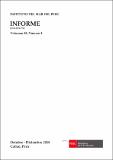Por favor, use este identificador para citar o enlazar este ítem:
https://hdl.handle.net/20.500.12958/3302Registro completo de metadatos
| Campo DC | Valor | Lengua/Idioma |
|---|---|---|
| dc.contributor.author | Bouchon Corrales, Marilú | - |
| dc.contributor.author | Ñiquen Carranza, Miguel | - |
| dc.contributor.author | Franco, Milagros | - |
| dc.contributor.author | Ttito, Hans | - |
| dc.date.accessioned | 2019-02-12T20:56:29Z | - |
| dc.date.available | 2019-02-12T20:56:29Z | - |
| dc.date.issued | 2018 | - |
| dc.identifier.citation | Inf Inst Mar Perú 45(4), 2018, p. 397-562 | es_ES |
| dc.identifier.issn | 0378-7702 | - |
| dc.identifier.uri | https://hdl.handle.net/20.500.12958/3302 | - |
| dc.description.abstract | La pesquería pelágica es una actividad productiva para el país y está representada por pequeños pelágicos como: anchoveta Engraulis ringens, sardina Sardinops sagax, jurel Trachurus murphyi y caballa Scomber japonicus. En el presente documento, se registran los desembarques anuales y mensuales de estos recursos, teniendo como fuente los muestreos realizados por Imarpe a lo largo del litoral peruano en el periodo 1959-2015. Estos recursos son capturados por embarcaciones conocidas como “bolicheras” y en el caso de anchoveta su destino principal es la producción de harina y aceite de pescado, mientras que sardina, jurel y caballa, lo es para consumo humano directo (D.S. 001-2002-Produce). La disponibilidad de estos recursos está asociada a las condiciones ambientales del mar peruano, siendo la anchoveta favorecida por condiciones frías y los otros pelágicos favorecidos por condiciones normales a cálidas. La principal estación de captura de anchoveta se registra en otoño mientras que en el caso de sardina, jurel y caballa en primavera-verano. Los records de desembarque anual fueron para anchoveta en 1970, para sardina en 1988, para jurel en el 2001 y para caballa en 1998. Los records de desembarque mensual fueron para anchoveta en mayo 1970, para sardina en enero 1991, para jurel en octubre de 2001 y para caballa en enero de 1999. En el acumulado total de estos recursos para el periodo 1959-2015 la anchoveta alcanzó 284.520.930 toneladas (84,4%), la sardina 42.090.513 toneladas (12,5%), jurel 7.053.914 toneladas (2,1%) y caballa 3.270.420 toneladas (1,0%). | es_ES |
| dc.description.abstract | ABSTRAC: The pelagic fishery is a productive activity for the country and is represented by small pelagic species such as: anchoveta Engraulis ringens, sardine Sardinops sagax, jack mackerel Trachurus murphyi and chub mackerel Scomber japonicus. In this paper, the annual and monthly landings of these resources are recorded, taking as a source the sampling carried out by Imarpe along the Peruvian coast during the period 1959-2015. These resources are caught by vessels known as bolicheras and, in the case of anchoveta, their main destination is the production of fishmeal and fish oil, while sardines, jack-chub mackerel are exclusively intended for direct human consumption. (D.S. 001- 2002-Produce). The availability of these resources is associated with the environmental conditions of the Peruvian sea, being the anchoveta favored by cold conditions and the other pelagic species favored by normal to warm conditions. The main season for catching anchoveta is in autumn, while for sardines and jack-chub mackerel is in spring-summer. The annual landing records were for anchoveta in 1970, for sardine in 1988, for jack mackerel in 2001 and for chub mackerel in 1998. The monthly landing records were for anchoveta in May 1970, for sardine in January 1991, jack mackerel in October 2001 and for chub mackerel in January 1999. In the total accumulated of these resources for the period 1959-2015, the anchoveta reached 284,520,930 tons (84.4%), sardine 42,090,513 (12.5%), jack mackerel 7,053 914 tons (2.1%) and chub mackerel 3,270,420 tons (1.0%) | - |
| dc.language.iso | spa | es_ES |
| dc.publisher | Instituto del Mar del Perú | es_ES |
| dc.relation.ispartofseries | Informe IMARPE;45(4), 2018 | - |
| dc.rights | info:eu-repo/semantics/openAccess | es_ES |
| dc.rights.uri | https://creativecommons.org/licenses/by/4.0/ | es_ES |
| dc.source | Instituto del Mar del Perú - IMARPE | es_ES |
| dc.source.uri | Repositorio Digital IMARPE | es_ES |
| dc.subject | Estadísticas pesqueras | es_ES |
| dc.subject | Pesquería pelágica | es_ES |
| dc.subject | Desembarques | es_ES |
| dc.subject | Recursos pelágicos | es_ES |
| dc.subject | Anchoveta | es_ES |
| dc.subject | Sardina | es_ES |
| dc.title | Estadísticas de la pesquería pelágica en la costa peruana (1959- 2015) | es_ES |
| dc.title.alternative | Statistics of the pelagic fishing in the Peruvian coast (1959-2015) | es_ES |
| dc.type | info:eu-repo/semantics/article | es_ES |
| Aparece en las colecciones: | Informe vol. 45(4) 2018 | |
Ficheros en este ítem:
| Fichero | Descripción | Tamaño | Formato | |
|---|---|---|---|---|
| Inf 45 4 Bouchon.pdf | 7,27 MB | Adobe PDF |  Visualizar/Abrir |
Este ítem está sujeto a una licencia Creative Commons Licencia Creative Commons

